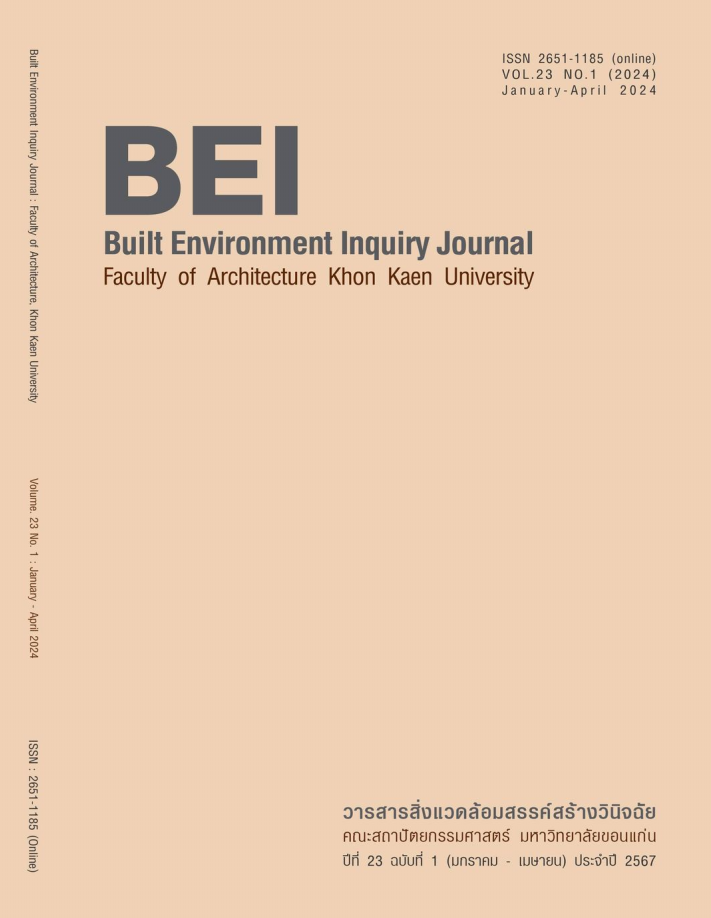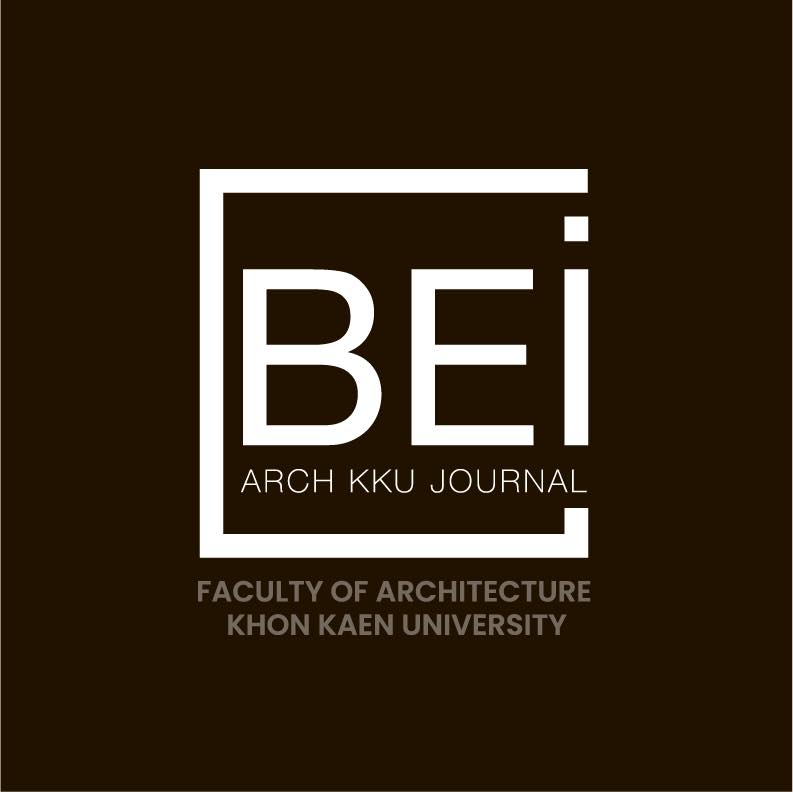Local Textiles Development to The Royal Peacock Certification Quality Thai Silk in Kalasin Province
DOI:
https://doi.org/10.14456/bei.2024.1คำสำคัญ:
Local textiles, Product standards, Thai silk, Kalasin provinceบทคัดย่อ
‘Local Textiles Development to The Royal Peacock Certification (The RPC) Quality Thai Silk in Kalasin Province’ is public-service, academic article of which presenting Kalasin local textiles elevating process in community-based producer and entrepreneur groups with regard to The Royal Peacock logo and standard certification by Participatory Action Research (PAR). The target population was 20 groups of producer and entrepreneur in Kalasin Province participated in textiles product analysis, workshop training series in The Royal Peacock Certificationstandard requirements, product prototype production for The RPC standard, standardcertifying process, and trends and benefit from standardization. The findings included the success in the silk and cotton textiles of the producer and entrepreneur groups were certified The Royal Peacock Certification standard as well with the elevating training process on knowledge, green technology and skills in natural dyeing and primary fiber inspection leading to certified silk products. The product results in standardization by authorized officials of The Queen Sirikit Department of Sericulture from all of the 20 groups (100%) and more in the groups have been producing to be certified with the trend in producing certified local textiles to a greater extent income increasing in community-base, silk product entrepreneurs.
เอกสารอ้างอิง
Adisak Jitphusa and Natthavara Jirandorn, (Online). Factors Affected in Efficiency of Betel Nut Solution in Cotton Dyeing. Rajamangala Bangkok Research Journal. 10(2), Searched from https://www.tci-thaijo.org/index.php/ rmutk/article/download/156784/113746/. 25 June 2021
Agricultural Research and Development Office (Public Organization), (Online). Thailand Agriculture Data Warehouse. Searched from https://tarr.arda.or.th/preview/item/vvFcNTrfC96g1mIjGh-Jj. 30 June 2021.
Bundit Muneenaem, (2013). Success in Ban Phon Praewa Silk Textile Community-Based Enterprise, Local Administration Journal. 6(2), 12-24.
Chaiwat Kaewkhlaikajonsiri and Prathabjai Sikkha, (2012). The Study of Indigo Dyeing with Green Banana Resin as Mordant Process. Architecture, Arts Academic Journal, Naresuan University. 3(1), 105-113.
Chipot, N, (online). Development of optimal dyeing methods with natural dyes for environmentally friendly hemp textile (Order No. 22623703). Available from ProQuest Dissertations & Theses Global. (2318150081). Retrieved from https://search.proquest.com/dissertations-theses/development-optimal-dyeing-methods-with-natural/docview/2318150081/se-2?accountid=31945
Kalasin Provincial Office, (2020). Kalasin Province Development Plan (2018-2022) (Revised 2020). Kalasin: Strategic and Information for Provincial Development Plan, Kalasin Province.
Kalasin University, (2019). Completion Report on OTOP Development for Standard Certification and Development of Outstanding Product in Kalasin Province. Department of Science Service, Ministry of Sciences and Technology.
Kan Inthuwong, (2015). Technology Transferring for Community Innovation Acceptation. Rajabhat Utradit University Journal. 10(2),1-10.
Kasiphat and Kosit Phaengsroi, (2019). Problems Solving Trends and OTOP Development Plan complying Buddhist Principle to Promote and Develop Community Based Enterprises in Udonthani Province. MahaChulaNaKhonThat Journal. 6(7), 3469-2488.
Kotchakon Sakunborisut and others, (2016). Effective Mordant in Natural Brown Dyeing Fixation. Srinakharinwirot University (Sciences and Technology). 8(15), 1-11.
Natthamon Harnsak and Others, (Online). “Development of Color Fastness Washing Test in The ROYAL PEACOCK CERTIFICATION Silk”. from https://tarr.arda.or.th/preview/item/vvFcNTrfC96g1mIjGh-Jj
Pawinrat Saetang, (2013). Value-added to Natural dyeing Textiles Product by Natural dyeing Process with Mordant from Jae Son Hot Spring, Muang Pan District, Lampang Province. Quality of Life and Community Development Journal. 1(1), 9-22.
Phannee Phornphakdee and Others, (2016). Perception of Consumers to The ROYAL PEACOCK CERTIFICATION Silk Textiles in Nakhonrachasima Province, Nakhonrachasima: Rajamangala University of Technology Isan.
Phongsri Rodphothong. (Online). ‘Study Cotton Natural Dyeing by Prong Tree’s Bark’. KMITL Faculty of Architecture Journal. 7(2), searched from https://so04.tcihaijo.org/index.php/archkmitl/article/view/4201.
Prach Harnklar and Phornsanong Wongsingthong, (2014). Women Garment Design to Develop Local Products to be National Products by Using Sustainable Design Concept: Case Study of Hand-Woven Textile of Wiang Chiang Rung District, Chiang Rai Province. Silapakam Sart Journal, Chulalongkorn University. 1(1),24-31.
Preecha Moolsin and Others, (2021). Natural Dyeing Silk textiles from Rubber Tree Leaves. Rajabhat Roi-et University: Sciences and Technology Journal. 2(1), 35-40.
Ratanaphol Mongkhonratanasith, Wirat Wongphakdi and Chachai Sirikasemlert, (Online), Qualification of Dyeing and Color Fastness in Silk and Cotton Textiles by Eucalyptus Trees’ Bark Extract Solution. Academica and Research Journal, RMUTP, Sciences and Technology. 1(1), searched from, https://ph02.tci-thaijo.org/index.php/RMUTP/article/view/22302.
Suphannee Phornphakdi and others, (2016). Perception of Consumers to The Royal Peacock Certification Silk Textiles in Nakhonrachasima Province, Nakhonrachasima: Rajamangala University of Technology Isan
Thanaphan Thongphoyai, (2020). The Value-added in Silk Product of Community Enterprises in Khon Kaen Province. Academic and Research Journal, Northeastern University. 10(3), 215-224.
Thanyamai Jianrakul, (2014). Problems and Adaptation Trends of OTOP in Preparation to AEC Open Trading. Executives Journal. 34(1), 177-191.
The Queen Sirikit Department of Sericulture, Zone5, Chumphorn Province, (Online). The Royal Peacock Certification. Searched from https://qsds.go.th/newqsissout/The Royal Peacock Certification,25 June 2021.
Wade M Vagias, editor, (2006). Likert-type scale response anchors. Clemson International Institute for Tourism & Research Development. Department of Parks. Recreation and Tourism Management: Clemson University.
ดาวน์โหลด
เผยแพร่แล้ว
รูปแบบการอ้างอิง
ฉบับ
ประเภทบทความ
สัญญาอนุญาต
ลิขสิทธิ์ (c) 2024 สิ่งแวดล้อมสรรค์สร้างวินิจฉัย

อนุญาตภายใต้เงื่อนไข Creative Commons Attribution-NonCommercial-NoDerivatives 4.0 International License.
ทัศนะและข้อคิดเห็นของบทความที่ปรากฏในวารสารฉบับนี้เป็นของผู้เขียนแต่ละท่าน ไม่ถือว่าเป็นทัศนะและความรับผิดชอบของกองบรรณาธิการ




